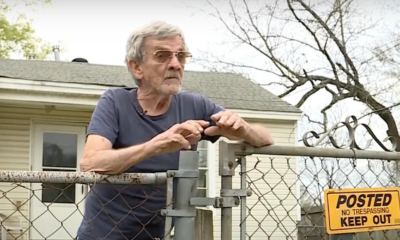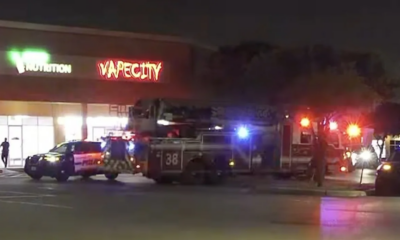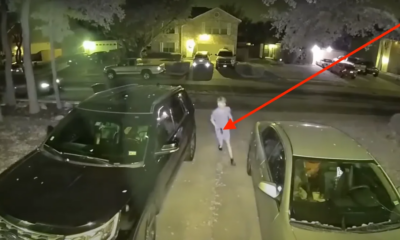Survival Stories
Remarkable Tales of Survival: From Amazon Jungle to Remote Australia

In a remarkable testament to human resilience, four indigenous children from the Huioto community in Colombia were rescued after spending forty days in the inhospitable Amazon jungle. The children, aged 13, nine, four, and 11 months, endured torrential rains, dangerous wildlife, and the presence of armed groups, emerging malnourished and covered in insect bites, but alive and without serious harm.
The youngest child even celebrated his first birthday amidst the dense foliage of the jungle. Their survival has been hailed as a “miracle” by Colombians.
“Education from their grandmother may have been vital to their survival,” said John Moreno, an Indigenous leader from nearby Vaupes.
In 1965, another extraordinary tale of survival unfolded when six schoolboys, aged between 13 and 16, were stranded on a rocky island south of Tonga in the Pacific Ocean for over a year. The boys, who had initially set out on a fishing trip, survived a storm and drifted for eight days without food, subsisting on rainwater collected in coconut shells, before washing ashore on the small island of ‘Ata.
By the time rescuers arrived 15 months later, the boys had established a functioning commune complete with a food garden, rainwater collection system, chicken pens, and a permanent fire. They had organized themselves into pairs, each responsible for garden, kitchen, and guard duties, and survived on a diet of fish, coconuts, tame birds, and eggs.
However, for Sione Filipe Totau, one of the stranded boys, the experience was far from a thrilling adventure.
“We [were] not happy where we [were],” Totau, known as Mano, told the Guardian in 2020. “If you were on a place, you don’t know where it is, and also you did not see any part of your family, I don’t think you’d be happy to be there … you won’t be happy until you see your family.”
In 2018, the world was gripped by the story of 12 young footballers and their coach who were trapped inside a flooded cave in Thailand for 18 days. The boys, aged between 11 and 17, and their 25-year-old coach, a former monk, survived on an elevated rock four kilometers from the cave mouth, with little food but sustained by meditation and the hope of rescue.
It took divers nine days to locate the team inside the six-mile Tham Luang cave in the Doi Nang Non mountain range, and another nine days to guide them to safety, a feat that cost two rescuers their lives.
In a different kind of survival story, seven-year-old Yamato Tanooka was left by his parents as a brief punishment on the side of a road in a Japanese forest. Believing he had been abandoned, Yamato ventured into the bear-infested woodland and survived nearly a week before being found by soldiers seeking shelter from the rain.
Yamato had managed to find an unlocked hut in a self-defence force training compound, where he stayed warm by squeezing between two mattresses at night. Despite not having eaten for almost a week, he was calm when found.
“He was incredibly calm considering he had been missing for seven days. He didn’t panic at all,” said the doctor who assessed him after his ordeal.
Ken Noguchi, a mountaineer who has climbed Mount Everest, tweeted: “If he survived by himself, it’s a miracle.”
In December 2022, a five-year-old girl in remote Western Australia performed an “absolute miracle” when she saved her two younger brothers, aged one and two, after a car crash that killed their parents. The girl managed to free the one-year-old from his seatbelt, while the two-year-old remained trapped for over two days.
The children waited beside their deceased parents for 55 hours in 30-degree heat before being found by family friends.
Michael Read, a cousin of the father who died, said it was difficult to imagine what the children would have been going through inside that vehicle. He described the five-year-old girl as a “bright kid, smart, intelligent, [who] absolutely loves cooking and playdough”.
Our Thoughts
The tales of survival shared in this article are nothing short of miraculous. Human resilience, ingenuity, and the will to survive are on full display here, particularly in the case of the indigenous children from Huioto community.
Their survival, despite the harsh conditions in the Amazon jungle, is a testament to the survival skills passed down through generations.
The story of the six schoolboys stranded on an island is another example of humans’ remarkable ability to adapt and survive in challenging conditions. Despite their ordeal, they managed to establish a functioning commune, demonstrating resourcefulness and organization skills beyond their years.
The harrowing experience of the young footballers trapped in a flooded cave in Thailand, and the seven-year-old boy surviving alone in a Japanese forest, underscore the importance of mental resilience in survival situations.
Finally, the five-year-old girl who saved her younger brothers after a car crash in remote Western Australia exemplifies the courage and determination that can emerge even in the most dire circumstances.
These stories are a reminder that survival is not just about physical strength or having the right gear, but also about mental fortitude, resourcefulness, and the will to keep going.
Let us know what you think, please share your thoughts in the comments below.

Survival Stories
Rep. Mace’s Capitol Encounter Sparks Controversy and Legal Battle

James McIntyre, a 33-year-old from Illinois, has pleaded not guilty to a misdemeanor assault charge following an incident involving Rep. Nancy Mace on Capitol grounds. The alleged encounter occurred on a Tuesday night, leading to McIntyre’s arrest for reportedly assaulting a government official.
The incident unfolded when McIntyre approached Rep. Mace and offered to shake her hand. According to a police affidavit, two witnesses observed the interaction and described McIntyre as a man in his forties. When Mace extended her hand, McIntyre allegedly clasped it with both hands and “shook her arm up and down in an exaggerated, aggressive hand shaking motion.”
Witnesses managed to identify McIntyre through an internet posting, providing his name and photo to the U.S. Capitol Police. Mace corroborated the witnesses’ accounts, stating that she attempted to withdraw her hand but was unable to do so. She reported feeling intimidated and experienced pain in her wrist, arm, and shoulder following the encounter.
During the aggressive handshake, McIntyre reportedly stated, “Trans youth deserve advocacy.” Mace refrained from responding during the incident, later expressing her shock and discomfort.
After the event, Mace took to social media to inform her followers of the situation.
“I was physically accosted tonight on Capitol grounds over my fight to protect women. Capitol police have arrested him,” Mace shared in a post on X. “All the violence and threats keep proving our point. Women deserve to be safe. Your threats will not stop my fight for women!”
She continued to discuss the incident on social media, revealing in one post that she had spoken with President-elect Trump.
“Thank you, Mr. President, for checking in on me and standing up for women,” Mace wrote. “We cannot wait to see you back in the White House.”
In another post, she shared an image of herself with her arm in a sling, highlighting the physical impact of the encounter.
The incident comes amidst Mace’s outspoken opposition to transgender individuals using bathrooms that do not align with their biological gender. She has been particularly vocal against Rep.-elect Sarah McBride, a Democrat from Delaware, using the women’s restrooms on Capitol Hill.
Mace has reported receiving death threats and feels she is being “unfairly targeted” for her stance. Her proposed resolution, H.R. 1579, aims to restrict bathroom use in the House to facilities matching one’s biological sex.
Following McIntyre’s arraignment in the Superior Court of the District of Columbia, a magistrate judge ordered his release. Meanwhile, Mace’s office has not provided an update on her condition.
Let us know what you think, please share your thoughts in the comments below.
Survival Stories
Unseen Advantage: Law Enforcement’s Rapid Adoption of Optics

In the world of law enforcement and survival, the ability to quickly and accurately assess a situation can make all the difference. This is why the rapid adoption of optics by law enforcement agencies is hardly surprising. These tools provide a wealth of visual information, aiding in making more informed decisions. A key factor in the selection of these optics is the window size, but it seems that co-witness sights, which can sometimes occupy half of the entire optic window, often don’t receive the attention they deserve.
“Without question, the speed with which LE agencies have adopted optics is testament to the advantage they offer: more visual information that yields better decisions.”
Interestingly, suppressor height sights are frequently paired with optics. To comprehend why this particular sight remains a popular choice when selecting co-witnessing sights, we must journey back in time. Around 2009, shooters, both professional and non-professional, began to repurpose a solution initially designed for Close Quarters Battle (CQB) rifle work for use on pistols.
The Trijicon RMR, a compact electronic optic, was a welcome alternative to the larger optics typically seen on competition pistols. Its smaller size offered more holster options, less likelihood of snagging in the field, and a more robust window and housing. As a result, it addressed many of the issues raised by professional users, leading to a shift towards an optics sighting solution within the firearms community.
“The smaller footprint meant more holster options, less to get caught on while in the field, and a less delicate window and housing.”
This shift was spearheaded by individuals in the military, law enforcement, defensive firearms instruction, and competition professionals. With the introduction of these optics, performance improved, and new shooters were able to develop accuracy and speed more quickly. The instinctual focal plane response to stress, which previously had to be trained out, could now be utilized as an asset by Firearms Instructors working with students who had optics on their pistols.
“Performance increased, accuracy and speed developed sooner with new shooters, the intuitive and instinctual focal plane response to stress no longer needed to be trained out—and instead, the threat-focus could now be an asset used by Firearms Instructors working with students who had optics on their pistols.”
As the popularity of optics grew, the aftermarket and firearms manufacturers responded by supporting this “new” sighting system. However, one critical component of the system was often overlooked: the back-up sights. This oversight highlights the need for a comprehensive approach to firearm optics, one that considers all elements of the sighting system to ensure optimal performance and safety.
Our Thoughts
The adoption of optics in law enforcement is a testament to the technology’s effectiveness. It’s no surprise that tools that enhance visual information, thus enabling better decision-making, have become a staple in the arsenal of law enforcement agencies.
The rise of the Trijicon RMR is particularly noteworthy. Its compact size and robust design addressed many of the practical concerns of professional users, leading to a broader acceptance of optics as a sighting solution.
The benefits of these optics extend beyond their practicality. They have brought about a shift in the training of new shooters, turning the instinctual focal plane response to stress into an asset rather than a hurdle to overcome. This has undoubtedly contributed to the improved performance observed among new shooters.
However, the focus on the main optic often results in the neglect of back-up sights. This is a reminder that a comprehensive approach to firearm optics is necessary to ensure optimal performance and safety. After all, a tool is only as good as the system supporting it.
Let us know what you think, please share your thoughts in the comments below.
Survival Stories
Mental Resilience: The Overlooked Key to Survival Success

In the realm of survival, we often focus on the physical aspects: the gear, the skills, the terrain. Yet, one crucial element often overlooked is our mental health. As a seasoned survivalist and a licensed mental health therapist, I’ve experienced firsthand the importance of mental resilience in a crisis.
I recall an incident during my first exploration of Red Rock Canyon. The vast, humbling landscape was a sight to behold, but it was also a formidable challenge. Despite my preparations, I found myself lost on a wild game trail, far from the intended path.
“Okay, no big deal,” I reassured myself. “I’ll just retrace my steps.”
But the creeping sense of panic was undeniable. I was low on water, surrounded by thick brush, and far from any signal. It was in this moment that my mental health training became as crucial as my survival skills.
“If anyone can figure this out, I can.” I thought. Or rather, tried to convince myself….
The human brain has a built-in survival mechanism known as the fight-flight-freeze response. When faced with danger, our heart rate increases, our pupils dilate, and our breathing becomes rapid. While these physiological changes can enhance our strength and speed, they can also lead to panic attacks, which can be detrimental in a survival scenario.
Soldiers and first responders are trained to manage this response, and so can civilians. Understanding mental health first aid can be a lifesaver in personal emergencies or when trying to calm someone else in a crisis.
“Okay…” I thought, “let’s just backtrack a little. See if I can’t find the main trail.”
I remembered the acronym S.T.O.P., taught in wilderness survival classes: Sit, Think, Observe, Plan. I sat down, focused on my breathing, and began to regain control of my racing thoughts.
“Breathe.” I thought. “In through the nose, slow. SLOW. Hold it for a few seconds. Now release through the mouth even slower. Pause. Repeat.”
I knew I had to control my thoughts to improve my feelings and make good decisions. Catastrophic thinking like “I’m gonna die” or “What if a rattlesnake bites me?” could trigger panic mode.
“Okay, what do we know?” I thought. “I know I can’t be too far off-course, no more than a couple miles. I know a few people knew generally where I was going (but not the specific trailhead) and that I expected to be back by nightfall. I know I have survival training and some kit with me that would help me make it through the night if needed. I can do this.”
After observing my surroundings and assessing my resources, I made a plan. I decided to head in the direction of what I believed to be a road, using a large branch to tap the ground in front of me to ward off any potential rattlesnakes.
In the end, I made it back to my vehicle without having to spend the night in the desert. The experience was a stark reminder of the importance of mental health in survival situations.
In the aftermath of a crisis, people will be in panic mode. Knowing how to guide someone through the stresses of a crisis can help mitigate some of the negative effects of traumatic events.
First, ensure the scene is safe. Then, assess the group, find helpers, and triage the situation. Ground the person by asking them to describe their surroundings and their feelings. Encourage slow, deliberate breathing and validate their experiences.
Long-term effects of repeated activation of the fight-flight-freeze response can include panic attacks, nightmares, and flashbacks. If you’re prone to these symptoms and find the techniques described here aren’t helping, consider seeking help from a licensed therapist.
Remember, it’s not a matter of being weak or strong. Some of the bravest individuals I’ve worked with have sought therapy for their symptoms. It takes great strength and bravery to ask for help.
Since my experience in Red Rock Canyon, I’ve incorporated mental health first aid and awareness into my survival teachings. I’ve also adjusted my approach to hiking, ensuring I communicate my exact route and expected return time, carry more water, and stay focused on the trail.
Survival isn’t just about the physical. It’s about the mental too. And with the right skills and mindset, we can navigate any crisis with resilience.
Our Thoughts
This compelling account underscores the often overlooked but critical role mental health plays in survival scenarios. The author’s experience in Red Rock Canyon drives home the importance of not just physical preparation, but mental preparedness as well.
The fight-flight-freeze response, while instinctual, can be detrimental if not properly managed. As survivalists, we should heed the author’s advice and learn to control this response, much like soldiers and first responders are trained to do.
The S.T.O.P. method is a useful tool in regaining control of our thoughts and feelings in high-stress situations. It’s not just about physical survival skills, it’s about mental resilience and clarity of thought.
Moreover, the importance of understanding mental health first aid cannot be overstated. It can be a lifesaver, not just for ourselves, but for others in crisis.
Ultimately, the author’s story is a reminder that survival isn’t just about the gear, the terrain, or the skills — it’s about the mind too. And in the face of adversity, with the right mindset, we can navigate through any crisis with resilience.
Let us know what you think, please share your thoughts in the comments below.
-

 Tactical9 months ago
Tactical9 months ago70-Year-Old Fends Off Intruder with Lead-Powered Message
-

 Preparedness6 months ago
Preparedness6 months agoEx-Ballerina’s Guilty Verdict Sends Tremors Through Gun-Owner Community
-

 Tactical9 months ago
Tactical9 months agoVape Shop Employee Confronts Armed Crooks, Sends Them Running
-

 Preparedness4 months ago
Preparedness4 months agoGood Samaritan Saves Trooper in Harrowing Interstate Confrontation
-

 Tactical9 months ago
Tactical9 months agoMidnight SUV Theft Interrupted by Armed Homeowner’s Retaliation
-

 Survival Stories1 year ago
Survival Stories1 year agoEmily’s 30-Day Experience of Being Stranded on a Desert Island
-

 Preparedness4 months ago
Preparedness4 months agoArizona Engineer’s Headless Body Found in Desert: Friend Charged
-

 Preparedness4 months ago
Preparedness4 months agoBoy Saves Dad from Bear Attack with One Perfect Shot